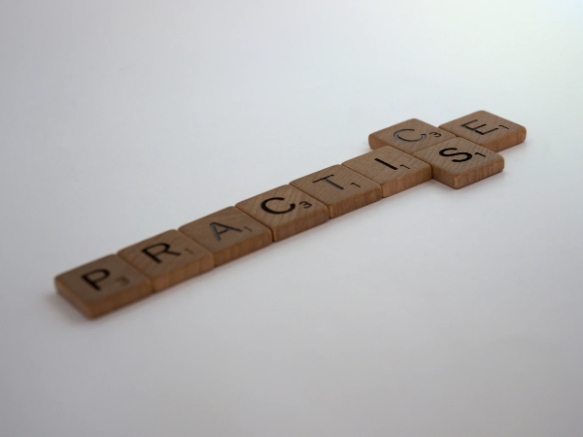
I just finished spending a wonderful week at Cisco Live EMEA and getting to catch up with some of the best people in the industry. I got to chat with trainers like Orhan Ergun and David Bombal and see how they’re continuing to embrace the need for people in the networking community to gain knowledge and training. It also made me think about a concept I recently heard about that turns out to be a perfect analogy to my training philosophy even though it’s almost 70 years old.
Practice Makes Perfect
Repetition without repetition. The idea seems like a tautology at first. How can I repeat something without repeating it. I’m sure that the people in 1967 that picked up the book by Soviet neurophysiologist Nikolai Aleksandrovitsch Bernstein were just as confused. Why should you do things over and over again if not to get good at performing the task or learning the skill?
The key in this research from Bernstein lay in how the practice happens. In this particular case he looked at blacksmiths to see how they used hammers to strike the pieces they were working on. The most accurate of his test subjects didn’t just perform the same movements over and over again. Instead, they had some variability in their skill that allowed them to be more accurate or efficient over time. They weren’t just going through the motions, as it were. They were adapting their motions to the need at the moment. This allowed them to adjust their aim if the piece had moved or needed a lighter touch in an area that was thinned too quickly.
Bernstein said this about the way that the blacksmiths practiced their art:
“The process of practice towards the achievement of new motor habits essentially consists in the gradual success of a search for optimal motor solutions to the appropriate problems. Because of this, practice, when properly undertaken, does not consist in repeating the means of solution of a motor problem time after time, but in the process of solving this problem again and again by techniques which we changed and perfected from repetition to repetition. It is already apparent here that, in many cases, ‘practice is a particular type of repetition without repetition’…”
The quote above illustrates a big shift in thinking for people who play sports or perform some kind of task. Instead of merely repeating the movements over and over again until perfection (the ‘means of the solution’) you should instead focus on solving the problem over and over again and adapting your skill to that end. It sounds silly and somewhat pedantic, but the key is in the shift of thinking. For basketball players, it’s not about perfecting your spin move to get around a defender. It’s about understanding the need to get around the defender and how best to accomplish that for different kinds of people defending you.
Avoiding Autopilot
Most of the content you’ll see around the concept of repetition without repetition is for sports players practicing skills. However, I think the concept extends perfectly to the IT certification space and troubleshooting skillset as well. There are a number of important things that we need to learn in order to do our jobs or earn a specialization but we need to remember that the goal is to solve problems and show mastery, not to memorize commands and perform them like a simple batch file.
Here’s a perfect example that I’m very guilty of doing. When you log into a Cisco router to do something, what do you normally do first when you get to the CLI prompt? You almost always need to be in privileged EXEC mode, right? That’s the enable command. When we want to configure something on the router we usually have to be in the router configuration mode, which is the configure terminal command. So far, so good, right? Most of you have already picked up on the fact that you can shorten those commands to save time typing out the whole name, which is an important skill to have when you’re configuring a series of devices or trying to do it in a short timeframe. So enable, configure terminal instead becomes en, conf t. It’s like muscle memory at this point.
How many times have you logged into router to check the routing table and accidentally typed in en, conf t from muscle memory only to remember that the routing table has to be displayed from EXEC mode, not configuration mode? You chide yourself for typing in conf t and back out to look at the table. But what you’ve really done is shown the power and drawbacks of repetition. If you spend hours upon hours typing in the same commands over and over again you will type them in the same way every time. So much so, in fact, that you forget that you’re doing it until you realize you put something in that you shouldn’t. You knew when you logged in that you wanted to display the routing table. You knew that was available in EXEC mode. And yet your brain and fingers automatically typed the same commends you always type when you log into the router.
The idea of repetition without repetition says that we need to consider the how of solving a problem and the skills needed above and beyond the simple skills themselves. Sure, there may only be one or two commands the achieve a desired output or effect but we should know how the both impact the performance of the device or how they can impact the outcome of a situation. This is especially important for exams that like to restrict your ability to use specific commands or are written to direct you in a specific line of thinking. Anyone who has ever taken the CCIE lab exam knows how this works. They restrict you from using common commands or give you a question with two possible answers only to limit that to one with a later requirement. The test asks you to configure something in an earlier section and then gives you a task that can undo that configuration if you’re not aware of how it interacts with everything else. If you’ve ever created a routing redistribution loop on accident you know what that feels like.
The Indictment of AI
In a way, repetition without repetition is the key of what makes a person an apt problem solver. By approaching problems with a mindset and not just a skillset you open your world to new possibilities and considerations. You know there is more than one way to skin a cat, as the old saying goes. You’re smarter than an artificial intelligence, which only works within a set of bounds with skills and apparent intelligence that repeats what it’s told or uses a very narrow focus every time to provide consistent results.
Computer programs and algorithms are dumb because they will solve the problem the same way each time they are executed. People will solve the problem and then start analyzing the results to find new, better, and faster ways to implement solutions. That’s the heart of learning. It’s not just performing the subtasks of the skill to perfection every time. It’s about learning how to implement them in a better way each time and arrive at better solutions to problems with the variables are changed. It’s why the human mind that has been adapted for centuries and millennia to look for patterns can be tricked into adapting those patterns to new concepts and made to “grow up” by learning over time to adjust to new inputs or fresh data. That, more than anything, is why repetition without repetition makes us better than the AI we’re programming to eclipse us.
Tom’s Take
When I first heard of this concept I thought it was some new idea from sports science that was borne from modern research techniques. I was shocked to learn it was discovered before I was born and has roots in some of the oldest trades we can think of. What it proves is that the human mind and body are very wonderful things that react perfectly when challenged in the right way. The brain will adapt and overcome when presented with new inputs. The way we grow and improve ourselves is not wrote memorization or continuous skill repetition. Instead, if we internalize the importance of the outcome over the means of getting there we will find ourselves smarter and more able to be flexible when new challenges come our way.












